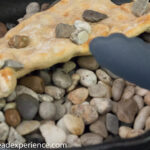Description
Sangak, also known as Persian Pebble Bread or Persian Army Bread, is a flatbread usually made with whole meal flour, and baked on a bed of hot stones.
Ingredients
Units
Scale
Leavener
- dessert spoonful culture (whole wheat 100% hydration starter) from the fridge (about 40 grams)
- 50 grams (50ml) room temperature water
- 50 grams (100ml, or approx. 1/3 cup + 4 tsp) 100% whole wheat flour
Dough
- 320 grams (2.5 cups + 1 Tbsp) unbleached ‘no-additives’ all-purpose flour (I used lightly sifted stone-ground whole grain flour)
- 5 grams (2 tsp) wheat germ
- 180 grams (180ml, or 3/4 cup + 1/2 tsp) room temperature water
- 1 dessert-spoon (about 25 grams) plain yogurt
- All of the leavener from above
- 8 grams fine sea salt + 20 grams water (1.33 tsp table salt + 1 Tbsp. water)
Instructions
Leavener
- Late in the evening on the day before you will be making the sangak, put a spoonful of culture from the fridge into a small bowl. Recently fed starter works the best. Feeding it a couple of days before you plan to bake is fine.
- Stir in 50 grams water and 50 grams whole wheat flour. Cover and let rest at room temperature overnight. In hot weather, 6 hours seemed to work the best in my Southern kitchen. When I let it rest longer, the leavener started to sink.
Actual Dough
- On the day you will be making sangak, in a large bowl, add the flour. Whisk in wheat germ.
- Add 180 grams water, yogurt, and all of the leavener.
- Using a dough whisk or wooden spoon, stir just enough to mix it together.
- Cover and leave on counter for about 20 minutes.
Kneading and adding the salt:
- Whisk salt and 20 grams water into a small bowl and pour on top of the dough.
- Wash your hands and leave one hand wet. With the back of your hand against the side of the bowl, reach down into the bowl to the bottom of the dough and pull it up to the fold it over the top.
- Turn the bowl with your other hand and repeat as necessary until the salt is thoroughly incorporated.
- Gradually incorporate more water if the dough tears.
Proofing:
- Cover the bowl and let rest on the counter for 2-3 hours.
- Check the dough from time to time. Wet your hands and gently fold it whenever it has doubled.
Cold ferment:
- After the dough has rested for 2-3 hours, cover tightly with plastic wrap, and place in the refrigerator overnight.
Preheating the Stones:
- Put the cast iron skillet with the stones into the oven on the top middle shelf and set the oven to 450F. I found that increasing the temperature to 480F worked better for my oven.
Shaping:
- While the stones are preheating, remove the dough from the refrigerator.
- Lightly flour the work surface, and divide the dough into 5 equal pieces. My dough weighed 685 grams so each dough ball was 137 grams.
- Cover the dough balls and let rest until the oven and the stones have preheated sufficiently, about 45 minutes (with my oven).
- Using lightly floured hands, work with one dough piece at a time so they don’t get too slack. With your fingers, press the dough ball out into a small oblong shape.
Baking:
- Remove the cast iron skillet from the oven using heavy oven mitts and place it on a heat resistant surface. Remove the oblong dough piece from the counter using a dough scraper and gently place it on top of the stones. This should be done very quickly. If the dough doesn’t sit perfectly on the stones, just leave it, don’t try to rearrange it.
- Place the cast iron skillet back in the oven and bake the bread for 3-5 minutes on one side, then using blunt-nosed tongs, flip it over and bake another 3-5 minutes on the other side.
- Remove any pebbles that are stuck in the dough with the tongs. If the stones are extremely reluctant to release themselves, it seems to indicate that the bread has not quite finished baking; simply bake it a little longer and try again.
- You may find it easier to remove the skillet from the oven before flipping the bread over especially if you need to remove any pebbles from the dough. It should take about 8-10 minutes to bake each bread.
- Baking one loaf at a time, repeat the above steps. Let the oven and stones preheat between each bake. If you have enough stones to fill the skillet completely, you can probably bake more than one loaf; however, if you have too many stones, it will be really heavy.
Cool slightly
- Break the bread apart and serve it immediately with Persian stews, Indian-style curries, chili con carne, soup…. It’s good with grilled vegetables too. I served mine with Cauliflower and Chickpea Masala.
- Category: Flatbread
